The Impact of Armed Conflict on Women and Girls - UNFPA
The Impact of Armed Conflict on Women and Girls - UNFPA
The Impact of Armed Conflict on Women and Girls - UNFPA
You also want an ePaper? Increase the reach of your titles
YUMPU automatically turns print PDFs into web optimized ePapers that Google loves.
One <str<strong>on</strong>g>of</str<strong>on</strong>g> the issues UNIFEM addressed was violence against children <strong>and</strong><br />
sexual abuse <str<strong>on</strong>g>of</str<strong>on</strong>g> children, mainly girls. When this author tried to talk to Kosovo-<br />
Albanian women about this serious issue, it was met with silence. Some <str<strong>on</strong>g>of</str<strong>on</strong>g> them<br />
nodded their head, indicating that they knew that this occurred, but they would<br />
not or could not talk about it. Violence against children is still a taboo, <strong>and</strong> there<br />
is no informati<strong>on</strong> available about its frequency or forms. It is known that teachers<br />
have l<strong>on</strong>g used violence in their work, as in beating pupils, <strong>and</strong> now there is<br />
some discussi<strong>on</strong> about forbidding such methods.<br />
<str<strong>on</strong>g>The</str<strong>on</strong>g>re is a reas<strong>on</strong> to look at activities <str<strong>on</strong>g>of</str<strong>on</strong>g>fered to boys versus girls in the<br />
Kosovar rec<strong>on</strong>structi<strong>on</strong> process. <str<strong>on</strong>g>The</str<strong>on</strong>g>re appear to be no gender-based<br />
programmes <strong>and</strong> other activities for teenagers, except possibly working, walking<br />
around <strong>and</strong> smoking. One <str<strong>on</strong>g>of</str<strong>on</strong>g> the things that Westerners notice in Kosovo is the<br />
use <str<strong>on</strong>g>of</str<strong>on</strong>g> child labour, which is forbidden in most European countries. Boys<br />
between <str<strong>on</strong>g>of</str<strong>on</strong>g> six <strong>and</strong> seven years <str<strong>on</strong>g>of</str<strong>on</strong>g> age sell cigarettes, lighters, teleph<strong>on</strong>e cards<br />
<strong>and</strong> other items across Pristina, late into the night. <strong>Girls</strong> are rarely seen selling in<br />
the streets. It begs the questi<strong>on</strong> if young boys have m<strong>on</strong>ey, while girls have<br />
n<strong>on</strong>e, or are these boys the breadwinners <str<strong>on</strong>g>of</str<strong>on</strong>g> their families? Am<strong>on</strong>g the Kosovo-<br />
Albanian beggars <str<strong>on</strong>g>of</str<strong>on</strong>g> Pristina, beggars include young boys <strong>and</strong> girls. While no<br />
informati<strong>on</strong> about their backgrounds or histories was available, given the str<strong>on</strong>g<br />
positi<strong>on</strong> <str<strong>on</strong>g>of</str<strong>on</strong>g> the Kosovar family, <strong>on</strong>e w<strong>on</strong>ders why <strong>and</strong> how certain people fall<br />
outside society’s safety net.<br />
Minority <strong>Women</strong><br />
<str<strong>on</strong>g>The</str<strong>on</strong>g> number <str<strong>on</strong>g>of</str<strong>on</strong>g> people bel<strong>on</strong>ging to the minority populati<strong>on</strong> in Kosovo is<br />
estimated to be about 200,000. Serbs are the largest group, followed by the<br />
Roma people, Turks, Goranci <strong>and</strong> others. After the c<strong>on</strong>flict, thous<strong>and</strong>s <str<strong>on</strong>g>of</str<strong>on</strong>g><br />
minority people fled the revenge <str<strong>on</strong>g>of</str<strong>on</strong>g> the returning Kosovo-Albanians. It is<br />
estimated that approximately 200,000 Kosovo-Serbs are internally displaced in<br />
Serbia. After a decade <str<strong>on</strong>g>of</str<strong>on</strong>g> c<strong>on</strong>flicts in the former Republics <str<strong>on</strong>g>of</str<strong>on</strong>g> Yugoslavia, the<br />
number <str<strong>on</strong>g>of</str<strong>on</strong>g> displaced pers<strong>on</strong>s in Serbia totals approximately 600,000 people.<br />
Efforts by the internati<strong>on</strong>al community to encourage minorities to return to<br />
Kosovo, including those by UNHCR, are so far without much success. 78<br />
<str<strong>on</strong>g>The</str<strong>on</strong>g> situati<strong>on</strong> <str<strong>on</strong>g>of</str<strong>on</strong>g> minority women in Kosovo calls for a special attenti<strong>on</strong>.<br />
Minority women face serious problems such as isolati<strong>on</strong>, insecurity, high<br />
unemployment rates, poverty, lack <str<strong>on</strong>g>of</str<strong>on</strong>g> freedom <str<strong>on</strong>g>of</str<strong>on</strong>g> movement, violence against<br />
themselves <strong>and</strong> their children, <strong>and</strong> limited access to social services. It is known<br />
that the birth rate is extremely high am<strong>on</strong>g Roma women, but the exact figure is<br />
not known. Infant <strong>and</strong> maternal mortality is also high within the Roma<br />
communities, al<strong>on</strong>g with poverty <strong>and</strong> illiteracy am<strong>on</strong>g women. Many Roma girls<br />
78 UNHCR <strong>and</strong> OCHA reports from Kosovo 2001.<br />
91



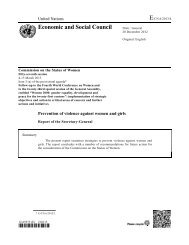
![IANSA [PDF, 2MB] - PeaceWomen](https://img.yumpu.com/25206379/1/190x123/iansa-pdf-2mb-peacewomen.jpg?quality=85)
![Commitments Sample [PDF, 93KB] - PeaceWomen](https://img.yumpu.com/25206331/1/190x245/commitments-sample-pdf-93kb-peacewomen.jpg?quality=85)

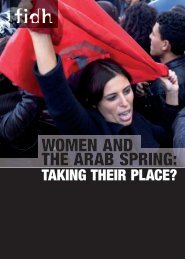
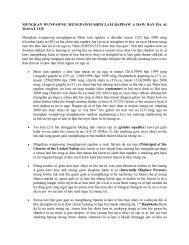
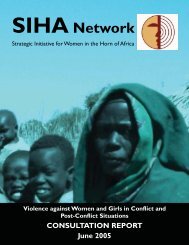

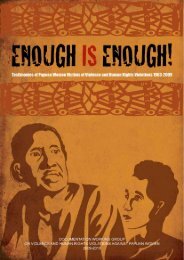

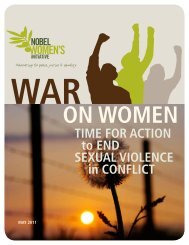
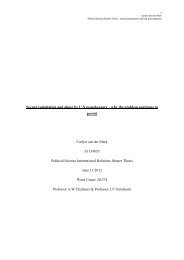

![A Toolkit for Advocacy and Action [PDF, 260KB] - Peace Women](https://img.yumpu.com/25205989/1/190x245/a-toolkit-for-advocacy-and-action-pdf-260kb-peace-women.jpg?quality=85)